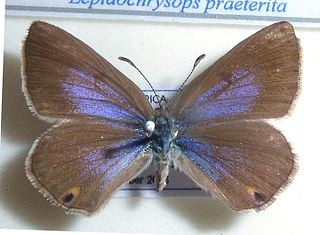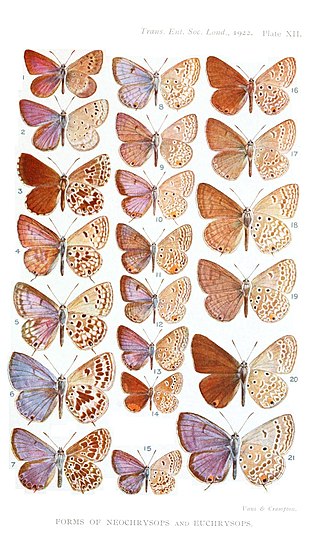
Aloeides dentatis, the Roodepoort copper, is a species of butterfly in the family Lycaenidae. It is found in Lesotho and South Africa.
Aloeides merces, the Wakkerstroom copper, is a species of butterfly in the family Lycaenidae. It is endemic to South Africa, where it is known from sour montane grassveld in KwaZulu-Natal and Mpumalanga.

Chrysoritis oreas, the Drakensberg copper or Drakensberg daisy copper, is a species of butterfly in the family Lycaenidae. It is endemic to South Africa, where it is found in montane grassland in the eastern KwaZulu-Natal Drakensberg foothills.
Lepidochrysops pephredo, the Estcourt blue, is a species of butterfly in the family Lycaenidae. It is endemic to South Africa, and is found in the grassy hills of the KwaZulu-Natal midlands.
Lepidochrysops swanepoeli, the Swanepoel's blue, is a species of butterfly in the family Lycaenidae. It is endemic to South Africa, where it is found in montane grassland in the hills above Fairview and the Sheba Mines in Mpumalanga. There is also a single record from northern KwaZulu-Natal.

Pseudagrion citricola is a species of damselfly in the family Coenagrionidae. It is commonly known as the yellow-faced sprite.

Axiocerses tjoane, the eastern scarlet, common scarlet or scarlet butterfly, is a butterfly of the family Lycaenidae. It is found in East and southern Africa.

Trida barberae, or Barber's ranger, is a species of butterfly in the family Hesperiidae. It is found in southern Africa, from the Cape Province to Zimbabwe, Lesotho, Transvaal, the Free State and KwaZulu-Natal.

Nervia wallengrenii, also known as Wallengren's ranger or Wallengren's skipper, is a species of butterfly in the family Hesperiidae. It is found in South Africa, Zimbabwe and from Mozambique to Kenya. The habitat consists of grassland and woodland.

Parosmodes morantii, the Morant's skipper or Morant's orange, is a butterfly of the family Hesperiidae. It is found in KwaZulu-Natal, Eswatini, Mozambique, Botswana, Zimbabwe and from western Kenya to Ghana.

Acraea machequena, the machequena acraea, is a butterfly of the family Nymphalidae. It is found in Zimbabwe, Mozambique, Malawi, south-eastern Tanzania. It is also present in some areas of South Africa, the savannah in Limpopo and north of the Soutpansberg, as well as the lowland forest of northern KwaZulu-Natal.
Lepidochrysops ketsi, the ketsi blue, is a butterfly of the family Lycaenidae. It is found in South Africa.
Lepidochrysops ignota, the Zulu blue, is a butterfly of the family Lycaenidae. It is found in South Africa, from the KwaZulu-Natal midlands to Eswatini, Mpumalanga, Limpopo and Gauteng.

Lepidochrysops procera, the Potchefstroom blue, is a butterfly of the family Lycaenidae. It is found in South Africa, where it is known from the KwaZulu-Natal midlands to Mpumalanga, Gauteng, Limpopo Province and North West.

Lepidochrysops praeterita, the Highveld blue, is a butterfly of the family Lycaenidae. It is found in South Africa, from Potchefstroom in North West to Walkerville in Gauteng and Sasolburg in the Free State province.

Lepidochrysops patricia, the patrician blue, is a butterfly of the family Lycaenidae. It is found in South Africa, from the Western Cape to the Eastern Cape and to KwaZulu-Natal, the Free State, Gauteng, Mpumalanga, Limpopo, the North West and the Northern Cape.

Lepidochrysops asteris, the star blue or brilliant blue, is a butterfly of the family Lycaenidae. It is found in South Africa, where it is known from the Western Cape, along the Rivieronderendberge and the Rooiberg along the coastal ranges to the Eastern Cape and the KwaZulu-Natal midlands.
Orachrysops nasutus, the nosy blue, is a butterfly of the family Lycaenidae. It is found in South Africa.

Mylothris agathina, the eastern dotted border or common dotted border, is a butterfly of the family Pieridae. It is native to sub-Saharan Africa, particularly East Africa and southern Africa. In South Africa its range has spread westwards around the coast in the late 20th century, and it now occurs north of Cape Town to somewhat beyond Saldanha.













